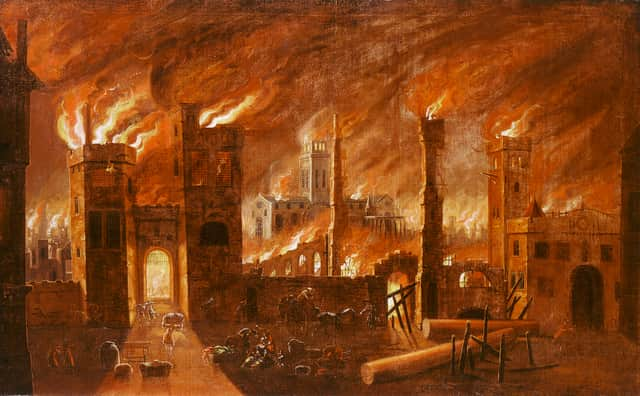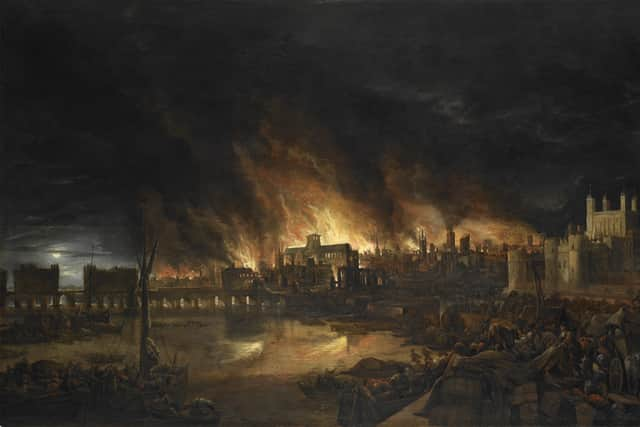Man who raised the alarm Great Fire of London is identified through detailed Museum of London research


A museum's detailed research project has identified the man who first witnessed and is believed to have initially raised the alarm when the Great Fire of London started.
The fire began on September 2, 1666 - 357 years ago - in Thomas Farriner’s bakery on Pudding Lane.
Advertisement
Hide AdAdvertisement
Hide AdThe research conducted by Professor Kate Loveman of the University of Leicester for the Museum of London has identified is shining a new light on the historic event that altered the UK capital's landscape.
Information from the time in letters, pamphlets, and other records have been combined to show that Thomas Dagger, a journeyman baker, “discovered” the Great Fire and raised the alarm.
The research undertaken for the museum’s new site in Smithfield (opening in 2026) used information known about Farriner’s home being the first of 13,200 houses destroyed in the Great Fire.


Reports differ on who was in the bakery when the fire started. A letter from the MP Sir Edward Harley offers the most detailed account. He wrote that Thomas Farriner’s ‘man’ (meaning his servant or journeyman) was woken after 1am ‘with the choke of the smoke’.
Advertisement
Hide AdAdvertisement
Hide AdFarriner, his daughter and his man then escaped out of an upper window, but his maid died. Other sources make no mention of the unnamed man or maid, but refer to Farriner’s son being present.
The information gained from the records provides the surviving members of the Farriner household. They were Farriner, his adult children Hanna and Thomas, and his ‘man’, who can now be identified for the first time as Thomas Dagger. It was Dagger who reportedly “discovered” the Great Fire and raised the alarm.
The research will inform galleries at the London Museum in Smithfield, which opens to the public in 2026. The museum’s popular Great Fire display will be reimagined, putting the stories of real Londoners at the forefront of a newly-designed, interactive space at the new site.
The research was funded by a project, Reimagining the Restoration, which has developed exciting new teaching resources on the Great Fire. These resources are now available on the Museum of London’s website for teachers and children who want to explore life in the 1660s.
Advertisement
Hide AdAdvertisement
Hide AdThe topic is especially pertinent to Key Stage 1 primary school learners, the majority of whom study the topic as part of the National Curriculum.
A key aspect of these new teaching resources is materials which show children, women, people of colour, and d/Deaf people at the time of the Great Fire of London. The project aims to give teachers new ways to teach the Great Fire, give learners a sense of place and ownership over their history, and to spark interest in the 17th century.
Kate Loveman, Professor of Early Modern Literature and Culture at the University of Leicester, said: “It was fascinating to find out more about what happened on that famous night. Although most of the evidence about the Farriners is well known to historians, Thomas Dagger’s role has gone unrecognised.
Unlike the Farriners, his name didn’t become associated with the fire at the time. Soon after the disaster, he merges back into the usual records of Restoration life, having children and setting up his own bakery. His is a story about the fire, but also about how Londoners recovered.”
Advertisement
Hide AdAdvertisement
Hide AdMeriel Jeater, Lead Curator for the Museum of London’s new Great Fire displays, said: “This discovery will feed into the exciting new ways in which we’ll be telling the story of the Great Fire of London in the London Museum.
“The museum holds a broad range of items relating to the Great Fire and our aim is to combine these with new research to create an immersive experience which foregrounds historical Londoners using their stories and their own words via letters and diary entries."
Comment Guidelines
National World encourages reader discussion on our stories. User feedback, insights and back-and-forth exchanges add a rich layer of context to reporting. Please review our Community Guidelines before commenting.
